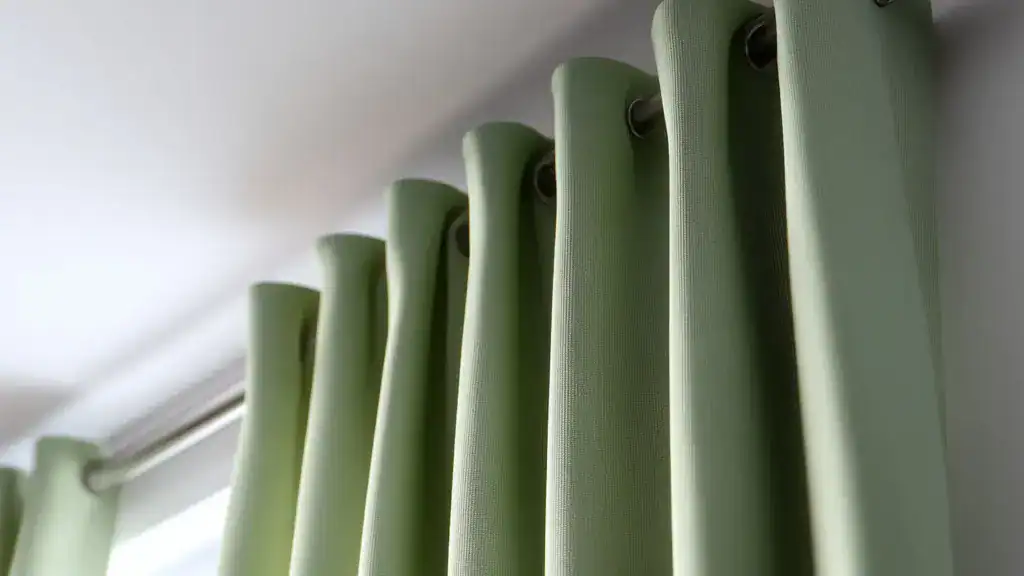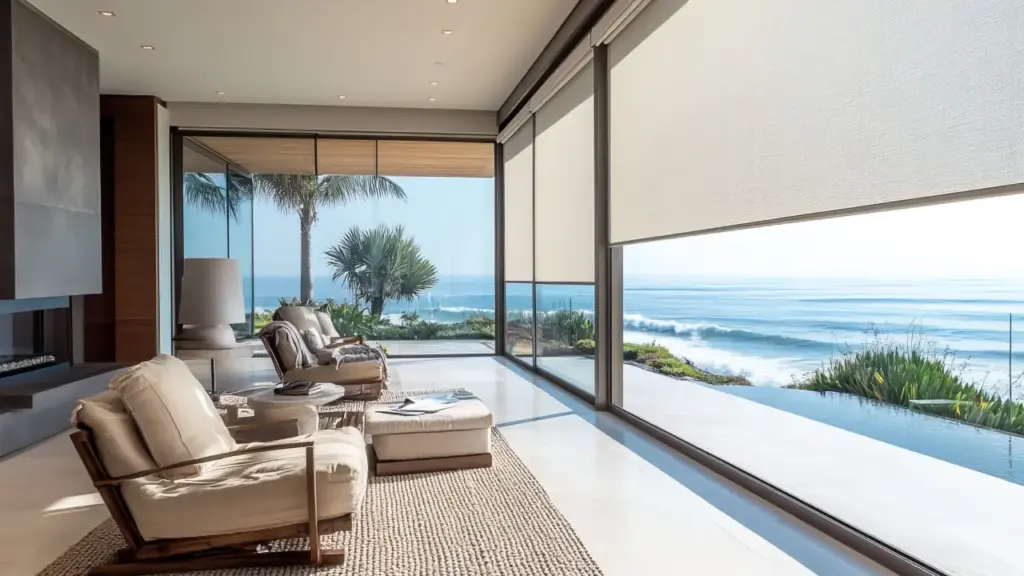Comparing Types of Blinds: Which Is Right for You?

Venetian blinds have ancient origins, possibly dating back to Egypt, where reeds were bundled into mats as early as 3100 BC.
John Webster, an upholsterer from London, introduced Venetian blinds as we know them today to the New World in 1767. Who knows — maybe that old set of blinds in your living room predates the American Revolution!
But while Webster’s blinds invariably featured wide wooden slats, you now have a broad choice of style and material.
In this post, we’ll explore the fascinating world of window blinds, comparing various types and providing insights into the best style and material for your needs.
Blinds Vs. Shades: What’s the Difference?
People sometimes use the words “blinds” and “shades” interchangeably. Even people in the business can be sloppy in this respect. However, blinds and shades are very different window treatments.
- Blinds are made of hard materials such as wood, metal, or vinyl slats that can be tilted to adjust the light entering a room.
- Shades are typically made of fabric and move up and down as a single unit to block.
In this blog, we’ll take a deeper dive into window blinds, while shades will have to wait for their own blog.
Types of Blinds
1. Venetian Blinds
Venetian blinds consist of horizontal slats attached by strings or strips of cloth called tapes. You can adjust them by tilting the slats up or down using a tilt wand or cord.
Pros
- Available in different materials such as wood, faux wood, and aluminum.
- Available in various colors and finishes to match any decor.
- Easily adjusted to control the light entering the room.
- Provide complete privacy when closed and allow for a view when tilted open.
- Extremely durable and long-lasting.
Cons
- Can be dust magnets, requiring regular cleaning.
- The cords or wands that adjust the slats can be a safety hazard for children or pets.
- More prone to jamming than other window treatments.
- Higher upfront cost.
2. Vertical Blinds
Vertical blinds have fabric or PVC slats that hang vertically from a track and can be tilted open or closed. They’re a common sight on sliding glass doors and large windows.
Pros
- Easy to clean and maintain since they collect less dust than horizontal blinds.
- Can cover large windows and sliding doors effectively.
- Available in various materials, including fabric, vinyl, and wood-like faux wood options.
- Allow for easy access to the door or window when pushed aside.
Cons
- The vertical slats can easily bend or break, making them less durable than horizontal blinds.
- Not suitable for small windows or rooms with limited space.
- Can be noisy when opened and closed due to the movement of the slats.
3. Mini Blinds
Mini blinds are similar to Venetian blinds but have narrower slats, typically measuring 1 inch in width.
Pros
- Great for small windows or spaces where larger blinds might look overwhelming.
- Easy to clean and maintain.
- Available in various materials, colors, and finishes.
Cons
- The smaller slats are more prone to bending or breaking.
- Unsuitable for large windows or areas that require maximum light control.
4. Panel Track Blinds
Panel track blinds are composed of wide fabric panels that slide across a track. They’re commonly used for patio doors and large windows.
Pros
- Provide a sleek, contemporary look to a room.
- Available in a variety of fabrics and colors to suit different styles.
- Easy to operate and allow for smooth control of natural light.
- Can double as a stylish room divider.
Cons
- The wide panels can limit versatility in light control when compared to slat blinds.
- Require sufficient wall space for the panels when opened.
- May be more expensive than traditional blinds due to their fabric and custom nature.
Window Blind Materials
1. Vinyl
Vinyl blinds are popular with homeowners due to their affordability and versatility.
Pros
- More budget-friendly compared to other materials like wood or fabric.
- Available in a wide range of colors, sizes, and finishes.
- Resistant to moisture and humidity, making them ideal for bathrooms and kitchens.
- Simple to clean with just a damp cloth.
Cons
- May lack the premium look and texture that wood or fabric blinds provide.
- Can warp or discolor when exposed to excessive heat or direct sunlight over time.
- Offer less thermal insulation than other materials.
2. Aluminum
Aluminum blinds are most often used in commercial spaces but have become increasingly popular in homes.
Pros
- Durable and resistant to wear and tear.
- Available in various colors, finishes, and slat sizes.
- Ideal for areas with high humidity or moisture, like kitchens or bathrooms.
- Easy to clean and maintain.
Cons
- Can be noisy when opened or closed.
- Limited options for light control compared to other materials like wood or fabric.
- May have a less premium appearance than other materials.
3. Wood
Wood blinds bring classic elegance and a warm feel to a room.
Pros
- Provide excellent insulation, helping to regulate the temperature inside a room.
- Available in various stains and finishes that lend warmth and character to a space.
- Durable and long-lasting when properly cared for.
- Can be a sound investment, adding value to a home.
Cons
- More expensive than other blind materials.
- Require more maintenance than vinyl or aluminum blinds — they may need refinishing or restaining at some point.
- Not suitable for high-humidity areas like bathrooms or kitchens.
4. Faux Wood
Faux wood blinds offer the look of natural wood at a lower cost and with added durability.
Pros
- Resistant to moisture and humidity, making them suitable for bathrooms and kitchens.
- Available in various colors and finishes that mimic natural wood’s appearance.
- More affordable than real wood blinds.
- Easy to clean and maintain.
Cons
- May not have the same authentic wood grain texture as real wood blinds.
- Can be heavier than other materials, making them less suitable for large windows or doors.
- Offer less insulation than real wood blinds.
5. Fabric
Fabric blinds are always vertical. They lack the support structure of slat blinds, which means they have a softer appearance and offer less light control.
Pros
- Available in various colors, patterns, and textures.
- Ideal for large windows or doors.
- Can add texture and softness to a space.
Cons
- May be more expensive than other types of blinds.
- Require more maintenance as they may collect dust or need occasional spot cleaning.
- Unsuitable for areas with high humidity or moisture.
FAQs: Types of Blinds
Q: What are the main differences between blinds and shades?
Blinds consist of slats that can be tilted for light control, while shades are made from a single piece of fabric or material that can be raised or lowered. Blinds offer precise light and privacy adjustments, whereas shades provide a softer, more contemporary look.
Q: Can blinds be custom-made to fit my windows?
Many manufacturers and dealers, including Aero Shade, offer custom blinds. Custom blinds have a more tailored look and can accommodate unique window shapes and sizes.
Q: How can I clean my blinds effectively?
Cleaning methods vary depending on the material. Vinyl and metal blinds can be wiped down with a damp cloth, while wood and faux wood blinds require gentle dusting. Always follow the manufacturer’s care instructions.
Q: What’s the best type of blind for high-humidity areas?
Faux wood and vinyl blinds are moisture-resistant and won’t warp or deteriorate like wood blinds.
Q: How do I ensure child safety with blinds?
Opt for cordless or motorized blinds. If you have corded blinds, use safety features like cord cleats and tension devices to keep cords out of reach of children.
Q: What maintenance do wood blinds require?
Wood blinds may need occasional dusting or cleaning with a wood-specific cleaner. Avoid using water, which can damage the wood finish. Additionally, they may need refinishing or restaining over time to maintain their appearance.
Q: Can I install blinds on my own, or should I hire a professional?
You can, but hiring a professional ensures proper fit and installation, especially for custom blinds or complex window shapes.
Q: How can I choose the right color and style of blinds for my home?
Consider your room’s existing decor and color palette. Neutral colors often work well with any design, while bold colors and patterns can make a statement. Also, consider the level of light control and privacy you desire. These factors can influence style selection.


